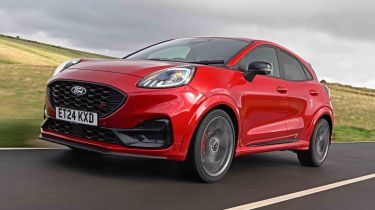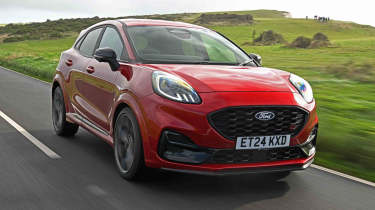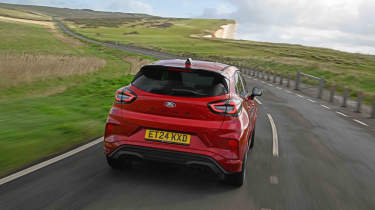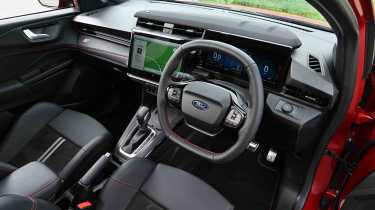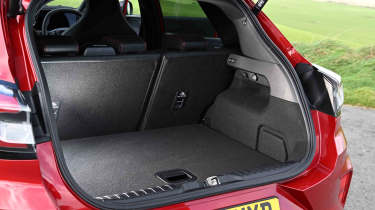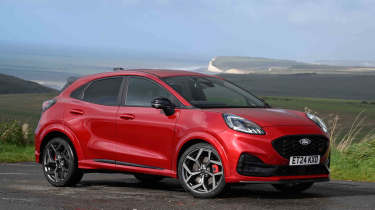Ford Puma ST review
The Ford Puma ST compact performance SUV is a shadow of its former self

Is the Ford Puma ST a good car?
Unfortunately, the facelifted Ford Puma ST is a pale imitation of its former self. The only engine and gearbox option that’s now available isn’t sporty enough to do the ST badge justice – we much prefer the discontinued manual version, because it’s quicker and more engaging to drive. The chassis and steering are as sharp and alert as ever, but they can only do so much to keep you entertained when the rest of the powertrain is such a letdown.
As a showcase for Ford’s performance badge, the Puma ST fails to live up to past glories, and a lower-spec ST-Line or ST-Line X model with the same engine in 123bhp or 153bhp auto guises is likely to be a better option. It will almost match the full ST look, but offer greater comfort on smaller wheels while still delivering an entertaining drive, and be cheaper to buy and run, too.
| Key specs | |
| Fuel type | Petrol |
| Body style | Five-door small SUV |
| Powertrain | 1.0-litre petrol mild-hybrid auto, front-wheel drive |
| Safety | Five stars Euro NCAP (2022) |
| Warranty | Three years/60,000 miles |
How much does the Ford Puma ST cost?
The Ford Puma ST is the flagship of the Puma range, so there’s just one model offered and a single engine option. Prices jumped with the car’s facelift in 2024, and the 1.0 EcoBoost auto starts from around £33,500, which is around £1,800 more than the old 1.5 EcoBoost manual.
Used - available now

2023 Audi
Q4 Sportback e-tron
54,526 milesAutomaticElectric
Cash £23,363
2022 Kia
Niro
18,315 milesAutomaticPetrol1.6L
Cash £17,900
2023 Nissan
Juke
40,858 milesManualPetrol1.0L
Cash £12,287
2022 Volkswagen
T-Roc
36,779 milesAutomaticPetrol1.5L
Cash £18,600The Puma ST comes as a five-door, five-seat small SUV, and there’s just one engine option to choose, the 168bhp 1.0-litre EcoBoost turbo three-cylinder with mild-hybrid assistance. One other change that has taken place is that the 1.0-litre model can now be upgraded with a Handling Pack for around £1,000 extra. This is slightly different from the old ST’s Performance Pack, because rather than adding a limited-slip diff and launch control, it adds KW coilover suspension.
From the middle of 2025 onwards, the Puma ST will be the flag bearer for Ford’s ST performance car badge. The first ST was the V6-powered Mondeo ST24 from 1996, but with electrification a very important part of Ford’s future, it will be interesting to see if ST can maintain a presence in the brand’s ecosystem. The fantastic Fiesta ST is long gone, and the company currently has the excellent Focus ST on its books, but the hatchback and estate are being prepped for the chopping block in 2025, leaving the Puma ST as the only model to wear the badge.
Engines, performance & drive
The biggest upheaval for the facelifted Puma ST is under the bonnet, where the selection of powertrains has been slimmed down from two to one. Gone is the 197bhp 1.5-litre three-cylinder EcoBoost and six-speed manual gearbox from the dazzling Fiesta ST, so that leaves the 168bhp 1.0-litre mild hybrid that was introduced shortly before the Puma’s recent facelift. And the reason for that powerplant’s introduction? To facilitate the option of a twin-clutch automatic gearbox.
So the Puma ST isn’t as fast as it once was, and the car’s power delivery is also let down by the seven-speed twin-clutch gearbox. When fitted with the manual, the Puma ST offered a level of connection and driving fun that made it genuinely feel like a high-riding Fiesta ST. But in comparison, the slow-witted auto ’box puts a dampener on the whole experience, because it doesn’t have the responses to cope with any kind of spirited driving.
Leave the transmission to its own devices, and the electronics struggle to ensure you’re in the right gear. This means the car can feel hesitant when exiting junctions, while increasing your pace on a twisty B-road leaves it fumbling for the right ratio in most situations. Accelerate out of a tight corner on to a straight, and there’s a hesitation as the gearbox kicks down, which spoils your momentum and flow if you’re looking for some driving fun.
It’s not much better when you take manual control of things. Paddles are fitted behind the steering wheel for shifting up and down, but there’s a delay between selecting the next ratio and the gearbox changing, which further hampers any enjoyment. Ford’s twin-clutch system isn’t a patch on the superb set-ups offered by the likes of Volkswagen and Hyundai in terms of response or engagement, with its slow reaction times feeling very much at odds with the sporty character that the company’s ST models should display.
This is a real shame, because in all other respects the Puma ST continues to deliver the same playful handling that made it one of our favourite performance SUVs. The steering is fast and direct, while the stiff chassis allows quick changes of direction and produces a level of enjoyment that more expensive performance SUVs struggle to match. The Puma will even lift an inside rear wheel if you’re attacking a particularly sharp corner, helping it maintain its character as a slightly higher-riding alternative to the Fiesta ST.
| Model | Power | 0-62mph | Top speed |
| Puma ST 1.0 EcoBoost | 168bhp | 7.4 seconds | 130mph |
| Puma ST 1.5 EcoBoost | 197bhp | 6.7 seconds | 137mph |
0-62mph acceleration and top speed
With around 30bhp less than the 1.5-litre model, performance has taken a bit of a hit. The 0-62mph time of 7.4 seconds is 0.7 seconds slower than the old car, while 248Nm of torque is 72Nm less than the 1.5-litre engine offered. Plus the full 168bhp is only available in ‘overboost’ mode – in regular driving, 10bhp is lopped off the engine’s output.
MPG, emissions & running costs
While the Puma ST has lost some of its sporting spark, the 1.0 EcoBoost and Powershift auto set-up comes with mild-hybrid tech to help boost fuel efficiency. Ford claims the electrified hot SUV will deliver efficiency of up to 47.9mpg and 135g/km of CO2 emissions, compared with 151g/km for the old 1.5 model. Ford also says that the seven-speed dual-clutch Powershift automatic gearbox has been optimised to work alongside the mild-hybrid system to ensure the engine remains in the optimum range for efficiency when cruising.
In terms of insurance, the Puma ST sits in group 21 when equipped with the mild-hybrid set-up, or group 22 with the 1.5-litre petrol engine. For context, the faster, but now-discontinued Hyundai Kona N sits in group 27 and the VW T-Roc R lands itself in group 33, so premiums for the Ford should be reasonable in comparison.
Our experts predict the Ford Puma ST will retain around 50 per cent of its original value over three years and 36,000 miles.
To get an accurate valuation on a specific model check out our free car valuation tool...
| Model | MPG | CO2 | Insurance group |
| Puma ST 1.0 EcoBoost | 47.9mpg | 135g/km | 21 |
| Puma ST 1.5 EcoBoost | 41.5mpg | 151g/km | 22 |
Design, interior & technology
The flagship Puma ST has been subject to the same round of updates as the standard model. There are minor revisions on the outside, with the most obvious change being to relocate the blue oval badge up front to the grille.
The ST continues to wear a subtly chunkier bodykit than the rest of the Puma line-up, 19-inch wheels, red brake calipers and a rear tailgate spoiler, plus it’s the only version that comes with matrix LED headlamps as standard – they’re an £800 option for the rest of the range.
The options list of the Puma ST is pretty small, with buyers able to add the Handling Pack that includes coilover suspension, a contrasting black finish for the roof, a different 19-inch wheel design and a round steering wheel for around £1,000 extra. There’s also a panoramic sunroof available for the same price.
Heated sports seats with six-way manual adjustment are fitted, but they now feature Ford Performance branding, replacing the Recaro items that have been used in the past, while synthetic leather and Alcantara trim add to the sporty appearance inside. The sports steering wheel is heated, too, while the multifunction buttons on its spokes include a drive mode selector that switches between Normal, Sport, Eco and Track settings.
Sat-nav, stereo and infotainment
The cabin has been overhauled with Ford’s latest SYNC tech, including a sizable 12-inch touchscreen with the climate controls now integrated within, plus more connectivity and safety kit than ever. There’s a 12.3-inch digital driver’s display as before, while wireless charging and smartphone connectivity is also available. If you want to take a break from listening to the Puma ST’s rorty three-cylinder soundtrack, Ford has fitted a 10-speaker Bang & Olufsen premium sound system that offers high-quality audio.
Boot space, comfort & practicality
While revisions have upset the Puma ST’s performance credentials, one feature that remains intact is the car’s practical cabin, which offers more room than you might expect for such a small SUV. Rear-seat space is acceptable for adults, but the car’s real party trick is the MegaBox in the boot, which will take up to 456 litres in five-seat mode.
The MegaBox is lined with plastic and has a drain hole that means you can store wet items inside. It’s deep enough that you can fit a set of golf clubs upright in the boot without any problems, or you can trade it for a space-saver spare wheel, which is available as an option. If you need extra space for longer items, folding the Puma ST’s rear seats down opens up 1,216-litre a cargo bay.
| Dimensions | |
| Length | 4,226mm |
| Width | 1,805mm |
| Height | 1,533mm |
| Number of seats | Five |
| Boot space | 456-1,216 litres |
Safety & reliability
There’s plenty of safety kit on board the Puma ST, and this includes the Driver Assistance Pack. It’s a £950 option across the rest of the range and features 360-degree cameras, adaptive cruise control with traffic-jam assist, blind-spot detection and lane-change and centring assist.
The Puma was tested by Euro NCAP in 2019 and earned a full five-star crash safety rating. However a reassessment at the end of 2022 saw the small SUV lose a star due to some poor results for adult occupant safety, causing its score in this category to fall from 94 to 75 per cent.
Ford finished a rather disappointing 30th out of 32 brands in our best car manufacturer rankings for 2024, but the Puma excelled in the model rankings, grabbing an excellent 10th place on the list of the 50 best cars to own, up from 33rd in 2023. Both lists are based on the results of our most recent Driver Power owner satisfaction survey.
| Key standard safety features | Euro NCAP safety ratings |
|
|
Ford Puma ST alternatives
The Puma ST is a relatively unique proposition in the small SUV class, because there isn’t another front-wheel-drive performance model like it. The Audi SQ2 and Volkswagen T-Roc R have sporty driving in mind, but they are four-wheel drive and considerably more powerful and expensive.
If it’s performance that you’re after, then the pre-facelift Puma ST is worth seeking out, or even the Fiesta ST on which it’s based, while the Hyundai Kona N is another model that’s rapid, but is based on the previous-generation model.
Frequently Asked Questions
As with the entire Ford line-up, the Puma ST comes with a three-year/60,000-mile warranty and 12 months of roadside assistance. There is the option to extend the warranty up to five years and 100,000 miles at extra cost.

